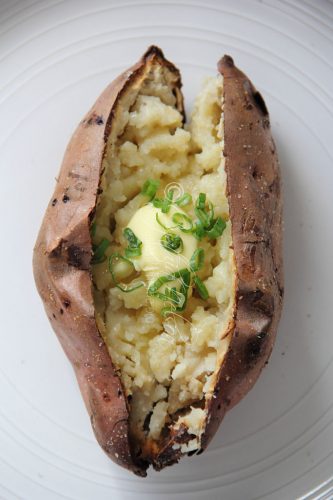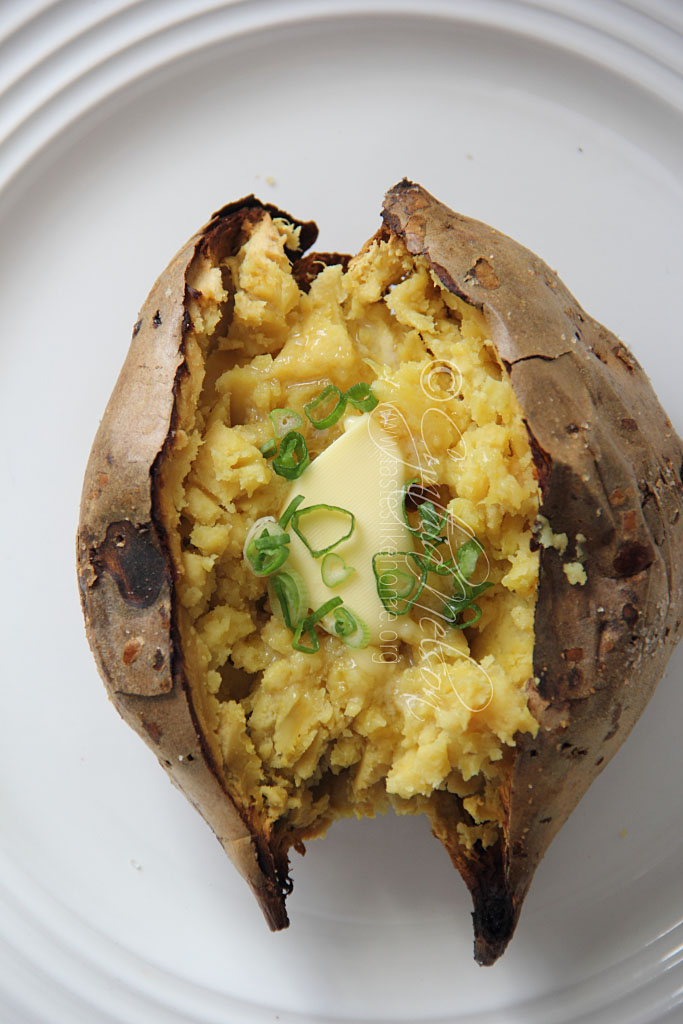 Don’t you just love the various ways in which you can prepare sweet potatoes? I know all the rage is about the orange-flesh sweet potatoes (aka as carrot sweet potatoes), but my preference is for the widely available white-flesh sweet potatoes we get in these parts. The texture and flavour are suitable to different styles of preparation, and among them is baked whole, think jacket (baked) potato.
Don’t you just love the various ways in which you can prepare sweet potatoes? I know all the rage is about the orange-flesh sweet potatoes (aka as carrot sweet potatoes), but my preference is for the widely available white-flesh sweet potatoes we get in these parts. The texture and flavour are suitable to different styles of preparation, and among them is baked whole, think jacket (baked) potato.
Packed with nutrients, sweet potatoes take less time to cook than English potatoes and provide fuel/energy that can keep you going for a long time. Last week at the market I found some of the yellow-flesh sweet potatoes and knew immediately that I wanted to bake them whole. It is not a variety seen often but whenever available I always get some. The skin is pale cream in colour, and it can easily be mistaken for the carrot sweet potato which has the same outer skin colour. When cooked, these sweet potatoes turn deep yellow. It is interesting that the carrot sweet potatoes come in two varieties with the outer skin being purple in one case and pale cream in another. I’ve used both varieties. The flesh of the purple-skin potato is sweeter, softer, and creamier when cooked. The flesh of the cream-skinned one is less sweet, and drier with more starch. The yellow-flesh sweet potato has the same texture and level of sweetness as its orange-flesh (carrot) counterpart of the same skin hue.

Anyway, while you may have had sweet potatoes in soups, served boiled and sliced or as a boil ‘n fry, fries, breakfast-style, in bread, or scalloped – all of which I have shared with you in previous columns, today, I am encouraging you to try them baked whole, just as you would an English potato. Cooked whole the potatoes can be served as a main dish with a variety of toppings, but really, they are so tasty on their own that all you need is a little butter and maybe a grinding of fresh black pepper. Or bake the potatoes and serve them as a side dish; either way, it’s a win-win.
Here’s how to prepare and bake sweet potatoes whole.
Preheat your oven to 400 degrees F and line a baking sheet with foil.
Wash and scrub the dirt from the outer skin and pat dry.
Prick the sweet potatoes in several places, all around with a fork – this is important because as the sweet potato cooks, the skin acts like a seal, trapping moisture that expands the potato and builds steam, if that steam cannot escape then the potato explodes, and you’ll have a lot of scrubbing and stuck on potato to remove from your oven.
Add the sweet potatoes to the lined baking sheet-tray. Drizzle oil and rub it all over the sweet potatoes. Sprinkle and rub salt over the sweet potatoes as well. Transfer the pan to the oven and let bake for 45 – 55 minutes.
The cooking time will vary depending on the size of the sweet potatoes. To check for doneness, put on an oven mitt and give the potatoes a little squeeze, if there is give and it feels tender, it is done, if it feels firm, then continue to cook for another 15 minutes and check again. Alternatively, insert a sharp knife or fork into the thick centre, there should be no resistance.
Remove the sweet potatoes from the oven, cut and serve them immediately or let them cool to room temperature to serve later.
To serve, simply cut across the middle of the potatoes, pry open and fluff the flesh with a fork and top with whatever topping you like. I read a tip online that said to drop the baked sweet potato from about 10 inches above a cutting board, pan or work surface, once or twice, and it will loosen the flesh of the sweet potatoes making it light and fluffy (I haven’t tried it but will do so the next time I bake up some sweet potatoes).
Try baking some sweet potatoes this weekend and let me know what you think.
I have a friend in Trinidad who plants the purple-flesh sweet potatoes; if only I can get my hands on some of those.
Cynthia
cynthia@tasteslikehome.org





